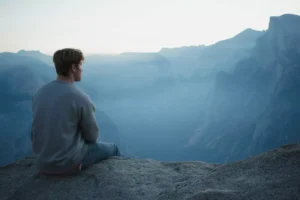It was a dark day. The darkest day in history, actually. Creation itself shouted the message as the sky turned dark from noon until three.
No one in Jerusalem could escape the groaning of creation — the midday darkness wouldn’t allow it. But for Jesus’ close friends and disciples, the cosmic billboard was unnecessary. The unthinkable had happened.
Jesus, the one they had come to believe was “the Messiah, the Son of the living God,” was taken from them in the dark of night, made to stand trial on false charges, and then handed over to the Romans. He was tortured beyond comprehension, spat upon, and mocked with a cruel crown of thorns.
The King of Glory was stripped naked in a futile attempt to rob Him of His dignity. The soldiers attending Him drove large nails through His wrists and ankles to secure Him to a cross. From an elevated position above the crowd, Jesus struggled to breathe, His own weight countering His efforts to push himself up for air.
This went on for hours. Jesus would shift His bruised and lacerated frame, using the nails in His hands and feet as leverage points, unthinkable pain the price for a short respite from impending suffocation. But He couldn’t struggle forever. Already physically weakened by the day’s brutal treatment, Jesus died before a soldier came around to break the legs of those who had been condemned.
The cross and the curtain
His disciples had scattered, and as the day’s events unfolded they were undoubtedly in shock, reeling from an onslaught of emotions that no one in this world had ever quite experienced. Some might say they were in mourning, but I don’t think that’s quite right. The wound was too fresh, the trauma too great. There is no category for the emotional pain that accompanies the death of God’s Son, the hope of all humanity.
Jesus had told His friends that He would be taken from them and killed. He had even declared that He would later rise from the dead. But in the haze of the lynching and the show trial and the brutalization of their friend, the disciples could not think clearly, nor could they recall all that He had said. And so, the darkness that had enveloped the sky that day seemed bright in comparison to the darkness that flooded their souls.
But as He often does, God left clues that revealed the darkness would not last. He left bits of hope in the midst of the enemy’s apparent triumph.
Matthew tells us, “And behold, the curtain of the temple was torn in two, from top to bottom” (27:51). While it’s unclear which veil is being described, the most likely is the curtain separating the Most Holy Place from the rest of the sanctuary (see Hebrews 6:19–20). The curtain was torn “from top to bottom,” ostensibly by the unseen hand of the Lord, opening the way for people to come into His presence.
Jesus had paid the price for our sins on the cross so that all who come by faith in Him will be welcomed — and not only welcomed, but adopted as sons and daughters. No sacrifice necessary. No blades. No blood. No blaze. Jesus paid it all.
Dead men walking
But then Matthew tells us about an event the other Gospel writers leave out of their narratives entirely, an event so strange it’s often excluded from Good Friday and Easter Sunday sermons. In the earthquake that rattled Jerusalem when Jesus died, rocks were split and tombs were opened, “and many bodies of the saints who had fallen asleep were raised” (Matthew 27:52).
In other words, Jesus wasn’t the only one who experienced the miracle of resurrection that weekend. Even stranger, these newly revived saints did not leave their tombs until Sunday morning, after Jesus emerged from His. When they did, they “appeared to many” in Jerusalem (v. 53), a detail Matthew likely included as a way of telling his readers, “If you don’t believe me, there are plenty of folks who can corroborate.”
But who were these saints? And what was Matthew’s — and by extension, the Holy Spirit’s — reason for telling us about this other resurrection?
It’s safe to say that, rather than being faithful men and women from the Old Testament era, these saints were followers of Jesus who had died recently. Because they “appeared to many” in the city, they must have been recognized. Otherwise, there would have been nothing to report. Lovers of God who had died years earlier, looking forward to the coming of the Messiah, would have appeared as strangers to the other people in Jerusalem. But it was known that these once-dead saints had risen. Therefore, in a world without photographs, they must have died recently enough to be identified by their friends and family.
These resurrected men and women were undoubtedly of the Lazarus variety, meaning that while they had been given new life, they were not yet glorified as Jesus was, and they died again sometime later. Their release from death was but a temporary reprieve.
Death put on notice
Except that the death and resurrection of Jesus turned everything on its head.
Jesus’ own resurrection proved that it was death that was temporary, not life. His victory over the grave was the great turning point of history. Prior to that Passover weekend, death had been the great villain from whom no one escapes. But when Jesus stepped out of that borrowed tomb, the cursed order of creation unraveled.
Death, the hostile invader in God’s good world, was put on notice. All those who had looked forward in faith to the day of Jesus’ coming, as well as the billions who would put their trust in Him down through the centuries that followed, would not be held down by death forever. The resurrection that Jesus experienced would come for them too. He was but the “firstfruits of those who have fallen asleep” (1 Corinthians 15:20). Now, all of us who love Jesus can join with both the prophet Hosea and the apostle Paul in asking with joyous mockery, “O death, where is your sting?” (v. 55; see also Hosea 13:14).
Just as the torn curtain in the temple declared that people could once again live in fellowship with God, so these resurrected saints mulling about Jerusalem on Easter Sunday were a living proclamation that the power of death had been undone. Both revealed just how good Good Friday really was.
Catching the light in our own eyes
These days, it’s easy to feel the weight of the darkness all around us and lose sight of the hope we have. With the reality of wars, natural disasters, broken family systems, a global mental health epidemic and more, the world seems to be spinning out of control.
Even when we know the truth of the gospel, it can be difficult to convince our hearts that the story God is writing — that you and I are a part of — really does have a happy ending. But just as the Lord did on Good Friday, He’s given us clues to remind us that the light is coming soon.
Because we serve a personal God, these reminders can be just as personal. The other day I was reading a passage of Scripture I must have read a hundred times before. But for some reason, this time as I read I could feel tangible joy welling up from within me, as though the Holy Spirit were pressing the words into my soul in a way that natural reading does not do. My eyes filled with tears, and every stress in my life fell off my shoulders.
Then there was this morning. I walked downstairs and stepped out the front door to observe the aftermath of a severe thunderstorm our little Tennessee town endured last night. I was caught off guard by the wonderful smell that lingers after a heavy rain. A moment later I heard the sound of pheasants foraging in the distance, their bright plumage contrasting with the green grass and the gray fog. The scene reminded me that my Father cares for the birds, so of course He cares for me too.
These are simple and specific reminders, but reminders of God’s goodness and the hope we have in Jesus are all around us if only we will listen and look for them. They’re in Scripture, in the gentle promptings of the Holy Spirit, and in the ordinary things of life. There are even miracles tucked in here and there if we have eyes to see and ears to hear.
This is God’s world, and if you know Jesus, then you are God’s child. Hope is a part of your inheritance, part of your life in Christ. This weekend, take some time away from social media. Put down your phone. Log off of your computer. Breathe deep of the things of God.
Read Scripture and ask the Holy Spirit to help you see the Father’s heart in its pages. When you’re outdoors, focus on the beauty that surrounds you. It’s a gift from the Lord, a reminder that Jesus is preparing a place for you in a world yet to come. And when you gather with brothers and sisters to hear the gospel story recounted on Easter morning, take special care to remind yourself that you are now included in that story. Jesus came for you — died for you — so that you could be set free.
Good Friday and Resurrection Sunday changed everything — absolutely everything — and the light of hope can’t help but shine through.
Copyright 2025 John Greco. All rights reserved.











